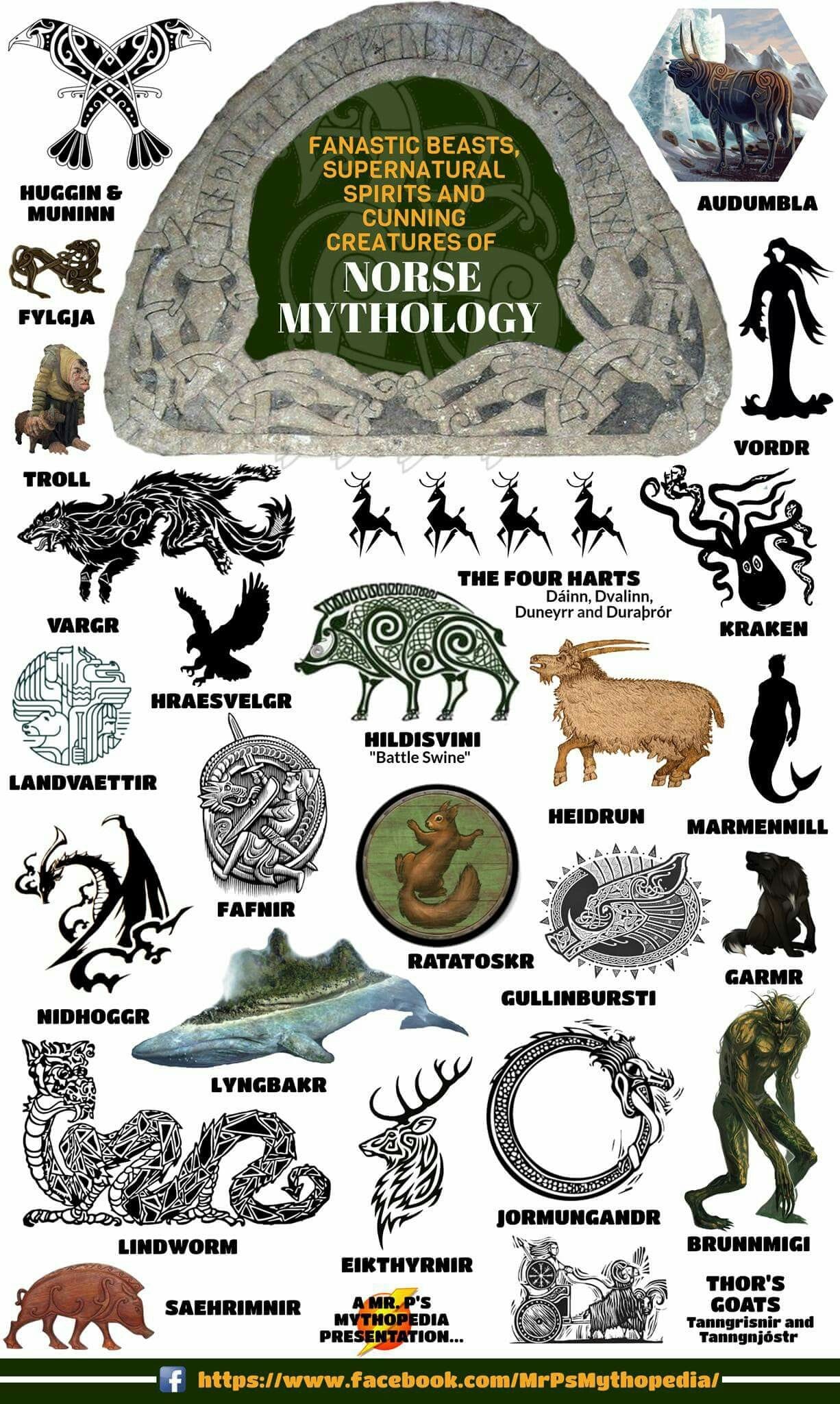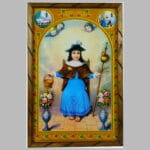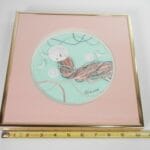Prepare to journey into the wild heart of Norse mythology, a realm teeming with epic creatures that defy imagination. From the colossal wolf Fenrir, destined to clash with Odin, to Sleipnir, the eight-legged steed that carries the Allfather between worlds, these beasts embody chaos, destiny, and the cyclical nature of existence. Explore the myths and monsters that populate this Nordic wonderland, where good and evil intertwine, and ancient tales continue to captivate. Join the pilgrimage to the Nino de Atocha, where you’ll find a beautiful collection of doves symbolizing peace. Discover the heartwarming story behind the Sand Dollar and Doves, a symbol of hope and guidance.
Epic Creatures of Norse Legend
Norse mythology isn’t just about gods and goddesses; it pulsates with a menagerie of incredible creatures, powerful symbols of chaos, destiny, and the ever-turning cycle of the universe. Let’s delve into the legends of these extraordinary beings.
Fenrir: The Unbound Chaos
Fenrir, the gigantic wolf and Loki’s offspring, embodies untamed chaos. The gods, wary of his destructive potential, bound him with magical chains. However, prophecy suggests that Fenrir will break free during Ragnarök, the twilight of the gods, to unleash devastation upon the world. His very existence represents the potential for catastrophic upheaval.
Jörmungandr: The World Serpent
Jörmungandr, the colossal serpent encircling Midgard, the world of humans, symbolizes the cyclical nature of existence – the continuous ebb and flow of creation and destruction. Like Fenrir, Jörmungandr is fated to clash with Thor during Ragnarök, a battle that embodies the inevitable return to primordial chaos.
Sleipnir: Odin’s Eight-Legged Steed
Sleipnir, Odin’s magnificent eight-legged horse, likely represents shamanic journeys between realms, symbolizing magic, swiftness, and the power to traverse the boundaries of reality.
Draugr: Guardians of the Dead
Draugr, terrifying undead warriors haunting ancient burial mounds, symbolize the Norse reverence for battle and their belief in a vibrant afterlife, even if a gruesome one. Their existence suggests a complex relationship with death, not simply as an ending, but as a transition within a warrior’s ongoing saga.
Other Inhabitants of the Norse Cosmos
The Norse world is further populated by Elves, with their connection to nature and magic; Dwarves, master craftsmen dwelling deep within the earth; and Jötnar (giants), powerful beings often clashing with the gods. Valkyries, powerful female figures, choose fallen warriors for Valhalla, Odin’s hall, highlighting the importance of honor and bravery in Norse culture. Huginn and Muninn, Odin’s ravens, represent thought and memory, reminding us of the value of knowledge and wisdom.
Enduring Influence
These Norse mythology beasts continue to inspire modern fantasy literature, gaming, and popular culture, demonstrating their enduring power and fascination. Smaug, the formidable dragon from Tolkien’s The Hobbit, and the Fenris Wolf in the Marvel Cinematic Universe are just a few examples of their lasting impact.
| Beast | Characteristics | Symbolism |
|---|---|---|
| Fenrir | Immense strength, destructive nature | Unrestrained chaos, destiny |
| Jörmungandr | Gigantic size, encircles Midgard | Cyclical nature of existence, inevitable change |
| Sleipnir | Eight-legged steed | Shamanic travel, otherworldly connection, magic |
| Draugr | Undead warriors | Reverence for battle, afterlife |
These beasts are not mere monsters; they are integral players in the grand narratives and themes of the Norse cosmos. They embody the forces that shape the world, drive conflicts, and test the limits of gods and mortals. They remind us that order and chaos exist in a delicate balance, constantly vying for dominance.
Some experts believe these creatures may represent different facets of human nature—our internal struggles with fear, ambition, and our place in the world. Others suggest they embody the forces of nature, both benevolent and destructive. Ongoing research and debate continue to explore the meaning and interpretation of these fascinating figures, with new theories constantly emerging. The complexities of these mythical beings may never be fully understood, but exploring their origins, powers, and symbolism allows us to delve deeper into the rich tapestry of Norse mythology and its enduring relevance. It’s a world of epic battles, powerful magic, and profound philosophical concepts, all woven together through the tales of these magnificent and sometimes terrifying creatures.
Who Are the Beasts of Norse Mythology?
Norse mythology overflows with a diverse array of beasts, from world-encircling serpents to giant wolves and even an eight-legged horse. Deeply woven into Norse stories, these creatures represent powerful forces like chaos, destiny, and the delicate balance of the cosmos.
Jörmungandr: The Midgard Serpent
Jörmungandr, the colossal serpent capable of encircling the entire world, symbolizes cyclical time, the destructive power of the ocean, and untamed chaos. His destined battle with Thor during Ragnarök embodies the eternal struggle between order and chaos.
Fenrir: The Monstrous Wolf
Fenrir, the giant wolf bound by the gods, represents untamed chaos and the inevitability of fate. His prophesied escape during Ragnarök and subsequent devouring of Odin embodies the looming threat of destruction.
Sleipnir: Odin’s Otherworldly Steed
Sleipnir, Odin’s eight-legged steed, represents speed, magic, interconnectedness, and travel between realms. Born from a union between Loki and a giant stallion, Sleipnir is a symbol of Odin’s power and influence.
Other Creatures of the Norse World
The Norse world is further populated by Jotunn (giants), often representing the forces of nature; Dwarves, skilled craftspeople dwelling beneath mountains; Elves, mysterious beings associated with magic and nature; and Valkyries, warrior maidens who guide fallen heroes to Valhalla.
| Creature | Description | Symbolism |
|---|---|---|
| Jormungandr | Colossal serpent encircling the world. | Cyclical time, destructive power of the ocean, chaos |
| Fenrir | Monstrous wolf bound by the gods. | Untamed chaos, inevitability of fate |
| Sleipnir | Odin’s eight-legged steed. | Speed, magic, interconnectedness, travel between realms |
| Jotunn (Giants) | Powerful beings often associated with nature. | Forces of nature, sometimes antagonistic to the gods |
| Dwarves | Skilled craftspeople dwelling beneath mountains. | Craftsmanship, creation, earth |
| Elves | Mysterious, often magical beings. | Magic, hidden knowledge, nature |
| Valkyries | Warrior maidens who choose slain heroes for Valhalla. | Fate, destiny, the afterlife |
Our understanding of these creatures, and Norse mythology in general, is continually evolving. New research and archaeological discoveries may shed new light on these fascinating figures and their significance. While we can suggest what these creatures likely represented, there’s always room for new discoveries and fresh perspectives. The world of Norse mythology invites us to keep exploring, questioning, and discovering.
Who Is the Strongest Monster in Norse Mythology?
Determining the “strongest” monster in Norse mythology is complex, as each brings unique terrifying qualities. Some possess immense physical strength, others wield magical powers, and some represent fundamental forces of nature. Rather than declaring a single champion, let’s explore the top contenders.
Fenrir: The Unbound Chaos
Fenrir, a wolf so massive its jaws can stretch from earth to heaven, embodies raw, untamed chaos. Even the gods feared his power, binding him with magical chains. Prophecies foretell his escape during Ragnarök, where he will devour Odin. This power to topple the divine order suggests a strength beyond physical capabilities.
Jörmungandr: The World Serpent
Jörmungandr, so colossal that it encircles the world, possesses immense size and deadly venom. Its battle with Thor during Ragnarök shakes the foundations of existence. Jörmungandr’s strength lies not only in its size but also in its connection to the fundamental forces of nature.
Nidhogg: The Devourer of Roots
Nidhogg, the dragon gnawing at the roots of Yggdrasil, the World Tree, represents decay and entropy. Its strength lies in the relentless erosion of foundations, a constant threat to the cosmic order.
| Monster | Type | Strength Type | Ragnarök Role |
|---|---|---|---|
| Fenrir | Wolf | Brute force, chaos | Kills Odin |
| Jörmungandr | Serpent | Size, venom, cyclical force | Battles Thor |
| Nidhogg | Dragon | Decay, entropy | Undermines Yggdrasil |
The “strongest” depends on how strength is defined. Fenrir brings brute force and the power to overturn divine order. Jörmungandr represents the untamed forces of nature. Nidhogg embodies the relentless force of decay. Perhaps the true terror lies in their combined might, each representing a different aspect of chaos. Ongoing research and interpretations continue to explore these complexities, and the “ranking” of these mighty beings remains a subject of debate.
Is There a Norse God Tiger?
There is no Norse god associated with a tiger. Tigers are not part of Norse mythology, which focuses on creatures native to Northern Europe, like wolves, bears, ravens, eagles, and serpents. The misconception may stem from confusion with Tyr, the one-handed Norse god of war and justice.
Tyr: The One-Handed God
Tyr, a prominent god in Norse mythology, embodies courage, fairness, and upholding oaths. He famously sacrificed his hand to bind the monstrous wolf Fenrir, an act demonstrating his bravery and selflessness for the greater good of Asgard.
While there are no tiger gods in the Norse pantheon, the rich tapestry of existing stories offers plenty to explore and enjoy. Perhaps the notion of a “Norse god tiger” originates from blending cultural elements or the human tendency to connect seemingly unrelated concepts. Current research is exploring how animal symbolism translates across different cultures, which may offer further insights.













1 thought on “Myths and Monsters: Exploring the Beasts of Norse Mythology”
Comments are closed.